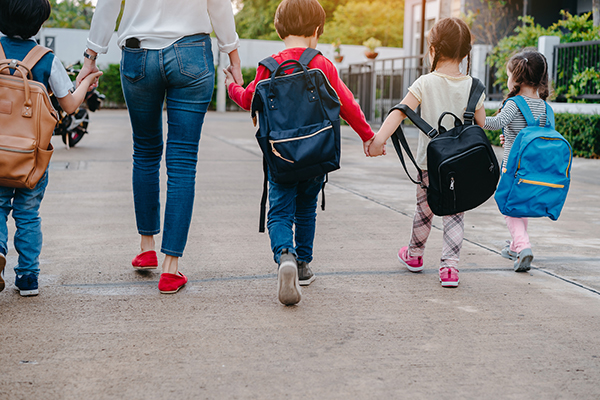
Taking the Weight Off: Backpack Safety Tips for Kids
In the beginning of the school year, Dr. John Blanco often sees more children and teenagers with back or shoulder pain. The culprit is often a heavy backpack. “In addition to being concerned about their child’s pain, parents worry that carrying a heavy backpack every day at school could lead to scoliosis,” explains Dr. Blanco, a pediatric orthopedic surgeon at HSS.
Although lugging around a heavy backpack or wearing it incorrectly could lead to sore muscles, Dr. Blanco emphasizes that it does not cause scoliosis, a hunchback or any other structural spine problem. “Although children and teenagers may experience back, neck or shoulder pain, there is no data to show that wearing a heavy backpack results in long-term damage or disability,” he says.
When a Backpack Causes Pain
Still, all complaints of pain or discomfort should be taken seriously, according to Dr. Blanco. If a child appears to be struggling with a backpack, he advises parents to take a look inside. Chances are something could be removed to make it lighter. From toys to video games to soccer shoes they don’t use every day, most kids are carrying around items they don’t need.
The American Academy of Pediatrics advises that backpacks should weigh no more than 10 to 20 percent of a child’s body weight. “It’s not uncommon for students to lug around 30 pounds, which is usually much more than 10 to 20 percent of their body weight,” Dr. Blanco says. “Most families have a scale at home, and they can use it to weigh the backpack and take out unnecessary items.”
Dr. Blanco also recommends that students check their backpack every day before they head to school, or the evening before, and take out extra books or supplies they won’t need.
Choosing a Good Backpack
In addition to carrying only the essentials to lighten the load, it’s important to choose a sturdy backpack and wear it properly, according to Dr. Blanco. He recommends spending some time to choose one that’s well-made. “This is something the student is going to be using every day during the school year, so it’s probably worthwhile to go to a store with a good selection. It should be fitted appropriately, and the student should know how to adjust it for a good fit.”
Dr. Blanco offers additional recommendations when choosing and using a backpack:
- Select a backpack with wide, padded shoulder straps and a padded back. Padding makes it more comfortable to wear and protects the back from books and other items with sharp edges.
- The backpack should be worn on both shoulders. Students should avoid slinging it over one shoulder. The idea is to distribute the weight evenly without putting excessive stress on one side of the body.
- Students should be instructed to tighten the shoulder straps so the backpack is close to the body. This will put less strain on the back.
- Purchase a backpack with a strap that goes around the waist and encourage kids to use it. This helps distribute the weight more evenly. If a backpack sways from side to side, the body has to work harder to balance it.
- The backpack should be organized to make the best use of compartments. Heavier items should be packed closest to the middle of the bag.
- Consider a rolling backpack if the school allows it and the child is willing to use it. However, this may not be practical if the student takes the stairs throughout the day.
- Students should be encouraged to use the school locker for storage whenever possible.
- Children and teenagers should be instructed on how to pick up the backpack properly to avoid back, neck and shoulder strain. They should bend their knees when lifting or wearing a backpack. They should not bend at the waist.
Dr. Blanco notes that sooner or later, many kids get used to the weight of the backpack as their muscles grow stronger. But it’s no fun being in pain, and spending some time to think about backpack safety and engage in good practices can prevent problems in the first place.


